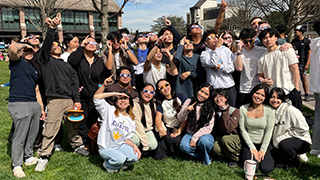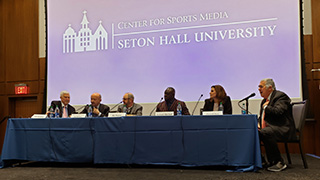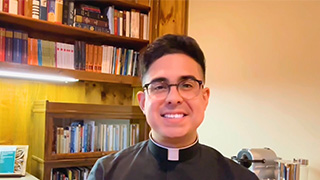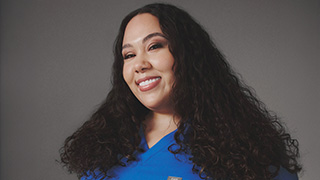Taking a Look at Two Sophomore IDTs
Wednesday, February 5, 2020
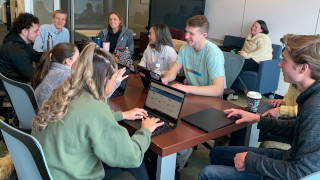
Seven ideas and subsequent CEOs were selected from the vote, and these leaders then went on to select their teams. At the beginning of the semester, all of the sophomores were asked to complete a personal branding video in which they were given two minutes to explain who they are, what they do, and what they could bring to the IDTs. The students also completed a DISC assessment, which gives insight into how they respond to others in different work environments. Each CEO was given access to every students' personal branding video as well as their DISC results, and they used these tools to craft a team that fit their desired dynamic.
This article features two of the Buccino Leadership Institute's sophomore CEOs Rachel Badway from the College of Arts and Sciences cohort and William Steck from the Stillman School of Business cohort. Badway's project is to design a leadership app that is accessible and designed specifically for college students while Steck aims to create an abroad trip that will be accessible to all of the students in the Institute. In the subsequent section of this article, Badway and Steck share a little bit about the inspiration behind their ideas and what they hope to accomplish by April.
When asked what made them decide to choose their ideas, Badway explained that she sees a huge gap in leadership development among college students, and that is why she wants to focus on developing an app. From a more personal standpoint, Badway believes this app can not only help others, but also herself, saying, "I came up with this project during my senior year in high school after having a conversation about how leadership development stops for most kids after high school. They tend to stop developing as a leader during one of the most important times in their lives." Steck also shared that his idea is backed by personal experience. He commented how, after attending the 9/11 and Gettysburf trips, both hosted by the Institute, a global experience just feels like a "next step" for him. Steck explains, "A global experience will afford our students the opportunity to see how leaders in other nations approach challenges and formulate solutions." The trips run by the Institute have been so successful in the past, and one to this level would be an incredible opportunity for all of the students involved.
Badway and Steck were asked what they are hoping to accomplish this semester and how far are they hoping their final product to reach/last for. Badway explained that she hopes her team will be able to generate all of the content and the general framework for the app, that way the eventual creation of the app will be seamless (even if this does not happen by the end of the semester). She hopes that when the final product is complete, it will be accessible to college kids everywhere. Steck shared that he too hopes his team can lay a strong groundwork for abroad trips so that it can become an annual opportunity for students each year. "We also want to ensure that trips offer robust opportunities for experiential learning," Steck explained, highlighting his teams' focus on a cultural, as well as academic, aspect of the trip.
Due to the fact that all of the CEOs were provided with the personal branding videos and the DISC results, Badway and Steck were asked if these specific tools were sufficient for them to choose their desired team members. Were there any strategies? "The process of deciding who I wanted on my time took a lot more energy and brainpower than I could have ever imagined," Badway admitted. She explained how she always considered herself to be very familiar with almost everyone in the Institute's sophomore class, however looking intricately at everyone's strengths in terms of her specific idea took a lot of time and effort. Her strategy was to go through all of the videos and DISC results, and then go back and determine who from each cohort was her top pick. However, she also accounted for the fact that she was not likely to get all of her top picks because another CEO would probably draft them first, and therefore she made sure she had backups. Steck came at the process with a similar strategy, reviewing all of the student's personal branding videos and DISC assessments. However, Steck additionally spoke with friends and instructors of members he was interested in to uncover who they are outside of the Institute's setting. He wanted to find members of the team that would contribute their own unique skills and perspectives, and his extensive research process ensured that his desired team would have skills that were both "diverse and complementary."
Since not everyone in the sophomore class made the choice to pitch an idea, Badway and Steck were asked if they had any prior experience coming in that made them more confident not only in their idea but also their skills to pitch it. Badway explained that she has been getting formal leadership training for as long as she can remember, and she incorporated a lot of the skills she has been developing since she was young into the implementation of this project. Public speaking has always been one of her strengths, and her ability to succeed so highly during the pitch allowed her to showcase her idea to her peers in the best light possible. Steck shared that he was also an IDT leader last spring during his freshman year, and his prior experience in this role allowed him to feel confident in his ability to lead another team this year. His background as a former leader will allow him to anticipate and handle any challenges that may arise this upcoming semester.
As to be expected, each CEO has big plans for their semester-long projects, and Badway and Steck each shared their idea of what a best-case scenario would look like for their specific teams. Badway believes leadership skills are helpful to everyone, especially in terms of succeeding in life after college. She shared, "The best-case scenario would be that we are able to develop a well-structured final project that's really able to help people develop all of the soft skills of leadership." Success for all is the ultimate goal. Steck's best case scenario not only involves the successful implementation of an abroad program, but also a more personal aspect. "My best-case scenario for this project includes each team member growing as a leader," Steck shares, emphasizing not only the growth of the Buccino Leadership Institute as a whole, but also the development of each individual team member.
Steck's idea of success sums up what the Institute is trying to achieve with the addition of IDTs to the curriculum. Not only does it give groups of young college students the opportunity to create something amazing, but it also encourages personal development as each student works with their team. Classroom lessons are great, but there is only so much they can teach. Gaining real, experiential learning at such a young age is proving to be highly beneficial to these sophomore leaders, as they are already each more confident in their skills after only one semester of IDTs. So far, all seven sophomore teams are off to an amazing start, and the presentations in April seem to be shaping up to be extremely successful and impactful!
Categories: Business


